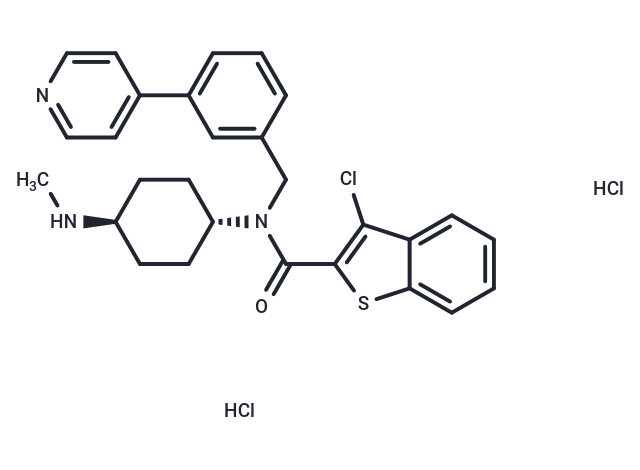Shopping Cart
Remove All Your shopping cart is currently empty
Your shopping cart is currently empty
SAG dihydrochloride, a powerful agonist of the Smoothened (Smo) receptor (EC 50 = 3 nM; Kd = 59 nM), effectively activates the Hedgehog signaling pathway. It also negates the effects of Cyclopamine inhibition on Smo.

| Pack Size | Price | USA Warehouse | Global Warehouse | Quantity |
|---|---|---|---|---|
| 1 mg | $48 | In Stock | In Stock | |
| 5 mg | $92 | In Stock | In Stock | |
| 10 mg | $123 | In Stock | In Stock | |
| 25 mg | $247 | In Stock | In Stock | |
| 50 mg | $372 | In Stock | In Stock | |
| 100 mg | $558 | - | In Stock | |
| 1 mL x 10 mM (in DMSO) | $227 | In Stock | In Stock |
| Description | SAG dihydrochloride, a powerful agonist of the Smoothened (Smo) receptor (EC 50 = 3 nM; Kd = 59 nM), effectively activates the Hedgehog signaling pathway. It also negates the effects of Cyclopamine inhibition on Smo. |
| Targets&IC50 | Smo:3 nM(EC50) |
| In vitro | SAG dihydrochloride, at concentrations ranging from 1-1000 nM for 1 hour, competes with BODIPY-cyclopamine for binding to Smo-expressing Cos-1 cells, resulting in an apparent Kd of 59 nM for the SAG/Smo complex. At doses between 0.1 nM to 100 μM over 30 hours, it activates firefly luciferase expression in Shh-LIGHT2 cells with an EC50 of 3 nM, but suppresses expression at higher concentrations. Additionally, 100 nM of SAG dihydrochloride counteracts the inhibitory effect of ShhN-induced pathway activation by Robotnikinin. When applied at 250 nM for 24 and 48 hours, it boosts CAXII mRNA levels at 24 hours under both normoxic and hypoxic conditions, and significantly augments SMO mRNA and protein levels at 48 hours in MDAMB231 cells. Furthermore, a 24-hour exposure to 250 nM of SAG enhances migration in MDAMB231 cells. |
| In vivo | SAG dihydrochloride (15-20 mg/kg; i.p.; mice) induces pre-axial polydactyly prevalently in a dose-dependent manner in mice.[4] SAG dihydrochloride (1.0 mM) induces more osteogenesis mainly at the defect borders and a significant increase in BV/TV at the eight week timepoint in CD-1 mice.[5] |
| Molecular Weight | 562.98 |
| Formula | C28H30Cl3N3OS |
| Cas No. | 2702366-44-5 |
| Smiles | O=C(C1=C(C2=CC=CC=C2S1)Cl)N([C@@H]3CC[C@H](CC3)NC)CC4=CC(C5=CC=NC=C5)=CC=C4.Cl.Cl |
| Relative Density. | no data available |
| Color | White |
| Appearance | Solid |
| Storage | store at low temperature | Powder: -20°C for 3 years | In solvent: -80°C for 1 year | Shipping with blue ice/Shipping at ambient temperature. | |||||||||||||||||||||||||
| Solubility Information | DMSO: 15 mg/mL (26.64 mM), Sonication is recommended. | |||||||||||||||||||||||||
| In Vivo Formulation | 10% DMSO+40% PEG300+5% Tween 80+45% Saline: 2 mg/mL (3.55 mM), Sonication is recommended. Please add the solvents sequentially, clarifying the solution as much as possible before adding the next one. Dissolve by heating and/or sonication if necessary. Working solution is recommended to be prepared and used immediately. The formulation provided above is for reference purposes only. In vivo formulations may vary and should be modified based on specific experimental conditions. | |||||||||||||||||||||||||
Solution Preparation Table | ||||||||||||||||||||||||||
DMSO
| ||||||||||||||||||||||||||
| Size | Quantity | Unit Price | Amount | Operation |
|---|

Copyright © 2015-2026 TargetMol Chemicals Inc. All Rights Reserved.